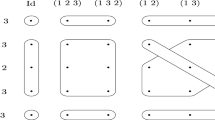Abstract
The “Principle of Increasing Mixing Character”, previously postulated by one of us (and derived for the case of an ensemble of isolated systems obeying a “master equation”) as a stronger version of the second law of thermodynamics, is re-derived using von Neumann's density matrix formulation of statistical mechanics. To make the principle more convenient for applications, it is reformulated in terms of “Mixing Homomorphic Functions”, a set of state functions all of which must increase in an allowed irreversible process in an-isolated system. The entropy is one such function, but no one function, and no finite set of functions, suffices to determine the increase of mixing character. The principle is extended to the case of a system which is not isolated, but in contact with a heat bath, for which it takes a form which we name the “Principle of Decreasing Mixing Distance” from the equilibrium distribution. As examples, applications are made to two simple cases: diffusion in an ideal solution, and chemical reactions in ideal gas mixtures.
Similar content being viewed by others
References
Ruch,E.: Theoret. Chim. Acta (Bert.)38, 167 (1975)
Ruch,E., Schiönhofer,A.: Theoret. Chim. Acta (Bert.)19, 225 (1970)
von Neumann,J.: Mathematische Grundlagen der Quantenmechanik, pp. 202–12. Berlin: SpringerVerlag 1932; English translation: Mathematical foundations of quantum mechanics, trans. by R.T. Beyer, pp. 379–398. Princeton: Princeton University Press 1955
Hardy,G.H., Littlewood,J.E., Pólya,G.: Inequalities, 2nd Ed., p. 49. Cambridge: Cambridge University Press 1952.
Uhlmann,A.: Wiss.Z., Karl-Marx-Univ. Leipzig, Math-Naturwiss. R.21, 421 (1972);22, 139 (1973)
Hardy,G.H., Littlewood,J.E., Pólya,G.: Ref. [4], pp. 70–72. These authors actually defineg to be convex if (-g) satisfies Eq. (11). We feel, however, that our definition is more consistent with normal usage in the physical sciences.
Planck,M.: Vorlesungen über Thermodynamik, 10te Auflage, durchgesehen und erweitert von M. von Laue, §134, pp. 98–9, and § 140, pp. 105–7. Berlin: Walter de Gruyter 1954; English translation: Treatise on thermodynamics, translated from 7th German Ed. (1922), by A. Ogg. New York: Dover Publications 1926, §133, p. 103, and §140, pp. 111–12. In Eq. (70) of the English edition, the symbol ≽ should be replaced by ≤.
Author information
Authors and Affiliations
Rights and permissions
About this article
Cite this article
Ruch, E., Mead, A. The principle of increasing mixing character and some of its consequences. Theoret. Chim. Acta 41, 95–117 (1976). https://doi.org/10.1007/BF01178071
Received:
Published:
Issue Date:
DOI: https://doi.org/10.1007/BF01178071



